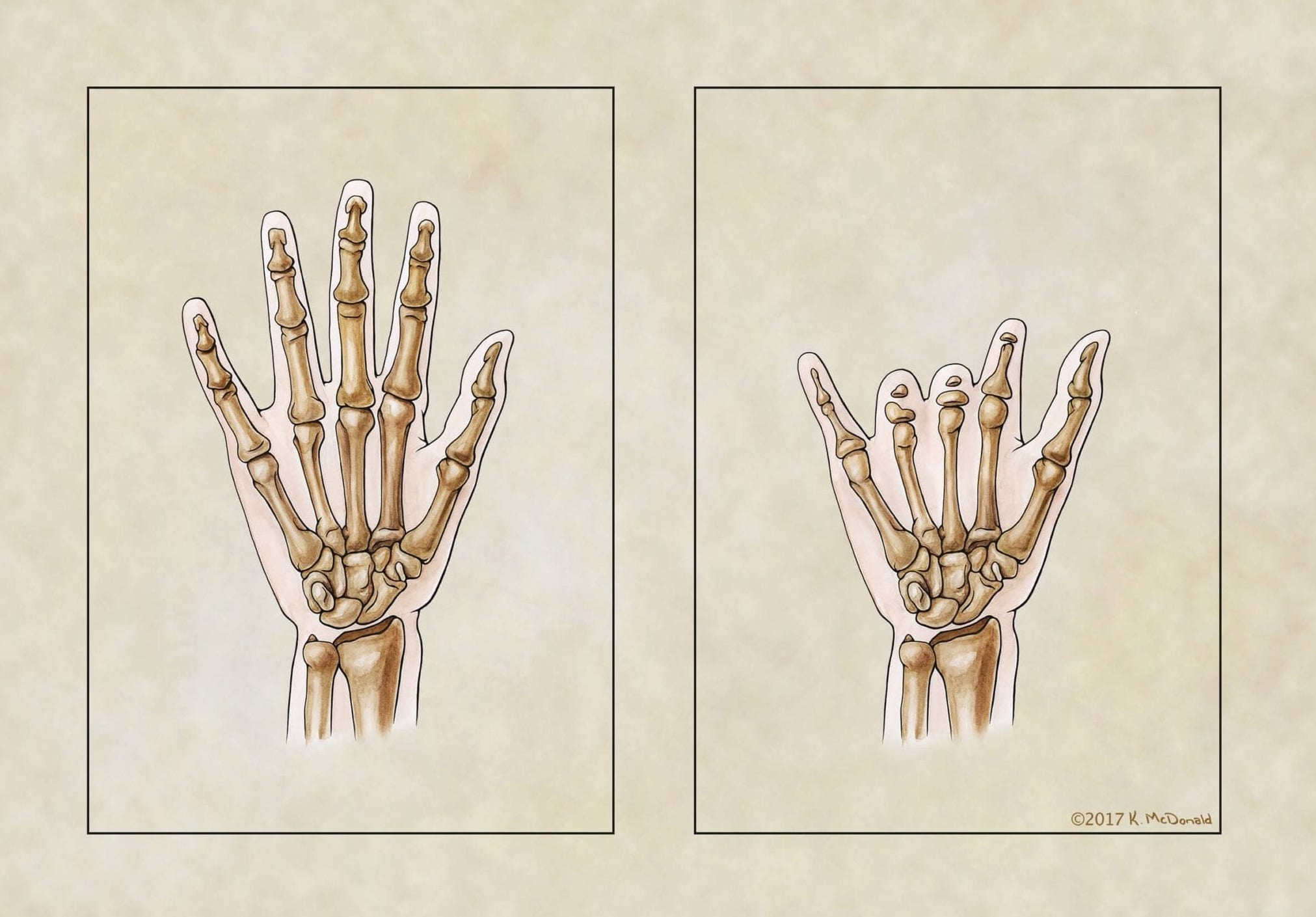Erin Crouch
Katelyn McDonald
Tacoma, Washington

Hands make us human. We lend a hand, we put all hands on deck, we know things like the back of our hands. Hands show emotion, beauty, and grace. But as Tolstoy wrote, “What a strange illusion it is to suppose that beauty is goodness.”1 Perfect hands do not make a perfect soul, and disservices are done when assumptions are made.
Ectrodactyly, a relatively rare limb malformation with median clefts of the hands and feet and lack or underdevelopment of phalanges, metacarpals, and metatarsals,2 occurs in around 1 in 90,000 births.2 Culturally, people have long been fascinated with deformities of the hand and ectrodactyly, sometimes called “lobster claw deformity,” was especially titillating to audiences in the nineteenth and twentieth centuries. People with the condition were exhibited in traveling shows3 and photographs and molds of the affected digits were displayed in cabinets of curiosity. Today such shows are rare and gawking at physical deformities is frowned upon. Yet ectrodactyly is still portrayed in an exploitive way on television.
In a visual medium like television, the physical deformity of the hand can be used as shorthand for a moral failing or problem, something that makes the character “less than,” or as a punishment for past offenses. TV Tropes, a website that explores conventions and devices in creative work, refers to this phenomenon as the Red Right Hand,4 that is, using a minor defect to provoke a negative audience response. The term “red right hand” itself is a reference from John Milton’s novel Paradise Lost, wherein God’s vengeful red right hand is sent to plague the demons.5 Viewed in this light, ectrodactyly is all too perfect as a symbol for perversion and weakness.
By far the most popular fictional character today in television with ectrodactyly is Jimmy Darling from American Horror Story,6 an American series on FX airing since 2011. Born with severe syndactyly, a form of ectrodactyly, Jimmy performs in a freak show, has a twisted sexual past, and is even framed for murder in the series. The television show Nip/Tuck (2003–2010) featured another character with ectrodactyly, the main character Sean McNamara’s son, Conor.7 Conor, first appearing in utero as a manifestation of McNamara’s insecurities as a plastic surgeon, was conceived during a time when McNamara’s marriage was falling apart, his physical deformities shown as problems coming back to haunt the main character. Carnivàle (2003–2005), on HBO, featured Sabina the Scorpion Queen, a role filled by an actor who actually has ectrodactyly, Bree Walker.8 Sabina gets her name from her “scorpion-like hands,”9 on which the camera endlessly focuses as she smokes and plots, and her ambiguously bad past, while alluded to, is never fully explored. Her main character development, it seems, is in her hands.
Without question, we are drawn to the idea of the hand in particular as a mark, an identifier of evil or an agent that acts on its own. Hand transplants, even disembodied hands, cause mayhem and violence in movies,10 exerting disproportionate influence on those around them. But both directors and we as audiences should resist the too-easy casting call of giving the “bad man” a “bad hand.” We should be able to see a character with ectrodactyly as disability without moral failure, if disability indeed needs to play a significant role in the story.
References
- Tolstoy, Leo, The Kreutzer Sonata and Other Short Stories, North Chelmsford, MA: Courier Corporation, 2012.
- Jindal G, Parmar VR, Gupta VK. Ectrodactyly/split hand feet malformation. Indian Journal of Human Genetics. 2009;15(3):140-142. doi:10.4103/0971-6866.60191.
- International Independent Showmen’s Museum. Traveling Shows page. http://showmensmuseum.org/traveling-shows/. Accessed December 3, 2017.
- TV Tropes. Red Right Hand page. http://tvtropes.org/pmwiki/pmwiki.php/Main/RedRightHand. Accessed December 3, 2017.
- Luxon, Thomas H., ed. The Milton Reading Room. https://www.dartmouth.edu/~milton/reading_room/pl/book_2/text.shtml. Accessed December 3, 2017.
- IMDb. American Horror Story. http://www.imdb.com/title/tt1844624/. Accessed December 3, 2017.
- Siegal, Mark. A delicate procedure for family. Los Angeles Times. September 25, 2006. http://articles.latimes.com/2006/sep/25/health/he-unreal25. Accessed December 3, 2017.
- IMDb. Bree Walker, Actress page. http://www.imdb.com/name/nm0483914/. Accessed December 3, 2017.
- Folk, Moe. Slights and Slants: Visual Representation in Carnivàle. Mediascape: UCLA’s Journal of Cinema and Media Studies. 2007. http://www.tft.ucla.edu/mediascape/Spring07_SlightsAndSlants.pdf. Accessed December 2, 2017.
- What Culture. Halloween Tribute: 10 Horror Movies With Disembodied Hands page. http://whatculture.com/film/halloween-tribute-10-horror-movies-with-disembodied-hands. Accessed December 2, 2017.
ERIN CROUCH (McDONALD) is a West Coast-based writer whose work can be found in Hektoen International and other publications.
KATELYN McDONALD is a Certified Medical Illustrator (CMI) whose work can be found on her website www.katelynmcd.com.

Leave a Reply